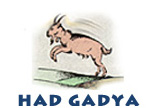

 |
 Click
on the speaker to hear the choral work: Had Gadya ("One
kid") byYehezkel Braun, performed by the Israel Kibbutz Choir,
conducted by Avner Itai. Courtesy of Beit Hatefutsot, Museum of the Jewish
Diaspora, Jewish
Music Dept. Click
on the speaker to hear the choral work: Had Gadya ("One
kid") byYehezkel Braun, performed by the Israel Kibbutz Choir,
conducted by Avner Itai. Courtesy of Beit Hatefutsot, Museum of the Jewish
Diaspora, Jewish
Music Dept. |
Had Gadya (An Only Kid, Aramaic) is a popular song sung in Aramaic
at the conclusion of the Passover seder along with other concluding songs,
to amuse the children and keep them from falling asleep. Composed of ten stanzas
the verse runs as follows:
A father bought a kid for two zuzim;
a cat came and ate the kid;
a dog then bit the cat;
the dog was beaten by a stick;
the stick was burned by fire;
water quenched the fire;
an ox drank the water;
a shohet (ritual slaughterer) slaughtered the ox;
the shohet was killed by the Angel of Death who
in punishment was destroyed by God.
Had Gadya follows a cumulative pattern in which
a new detail is added in each stanza; each stanza closes with the refrain which
includes all the items in reverse order, from the last back to the first —
"had gadya, had gadya (one kid, one kid), that father bought for
two zuzim." The cumulative pattern (which we see in other Passover songs
as well, such as Ehad mi Yodea) was most likely modeled after such popular
songs of Christian European origin, as "The Twelve Days of Christmas"
or "Alouette."
|
|
Woodcut
illustration for Had Gadya
Istvan Zador, Budapest, Hungary, 1924.
Haggadah text is in Hebrew and Hungarian.
Click
to view enlarged. |
|
|
|
|
Woodcut illustrations for
Had Gadya, Jacob Steinhardt Haggadah. Berlin, Germany, 1923
|
|
Most scholars agree that Had Gadya was borrowed from a late medieval
German folk song ("Der Herr der schickt den Jokel aus") which, in
turn, is based on an old French nursery song. Folklorist Joseph Jacobs[1]
points to the analogy of Had Gadya with Don Quixote and with certain
Persian and Indian poems.[2] The song ,
translated into the various vernaculars used by Jews and set to local tunes,
makes its first appearance as a Passover song in a haggadah printed in Prague
in 1590. It was never part of the Sephardi (Spanish) and the Yemenite rituals.
|
|
Woodcut
illustration for Had Gadya
Istvan Zador, Budapest, Hungary, 1924.
Haggadah text is in Hebrew and Hungarian.
Click
to view enlarged. |
|
|
|
Cover page of the Hebrew/Polish
Haggdah, with picture of The One Kid. Warsaw, Poland, 1928.
Click
to view enlarged. |
|
Despite its likely origin, Had Gadya has been
vested by Jewish commentators[3] with allegorical
meaning. According to one popular interpretation, the kid symbolizes the oppressed
Jewish people, which was bought by the father (God) for two coins (Moses and
Aaron). The subsequent players in the ballad represent the nations who persecuted
the Jewish people over the centuries: the devouring cat represents Assyria;
the dog–Babylon; the stick represents Persia; the fire Macedonia; the water
is Rome; the ox, the Saracens; the shohet (ritual slaughter)–the Crusaders;
and the Angel of Death, the Turks who subsequently ruled Palestine. The end
of the song expresses the hope for messianic redemption: God destroys the foreign
rulers of the Holy Land and vindicates Israel as "the only kid."
According to other, mystical interpretations, Had
Gadya is an allegorization of the Joseph legend, or alternatively, of the
relationship between body and soul as reflected in Jewish mysticism.
|
[1] Jewish
historian, folklorist and scholar (1854-1916), born in Australia and later
studied in England and Germany, researched Jewish ethnology, anthropology
and biblical archaeology. [back]
[2] Joseph Jacobs, English Fairy Tales, London,
1893. [back]
[3] * Kerem Ein Gedi, by Juda b. Mordecai Horowitz
(Koenigsberg, 1764)
* Jonathan Eybeschuetz (Neubauer Cat Bodl. 1 (1886), no. 2246
* Gaon of Vilna (Haggadah Migdal Eder, Vilna, 1923)
* R. Moses Sofer (also in: Haggadah Migdal Eder, Vilna, 1923).
[back] |
GOATS Table of Contents
|